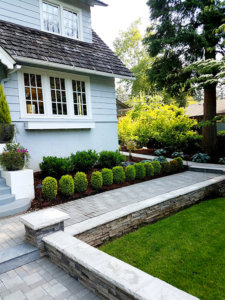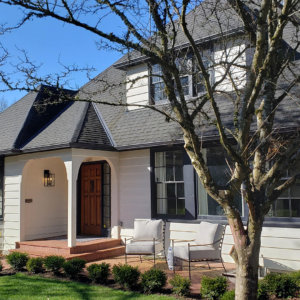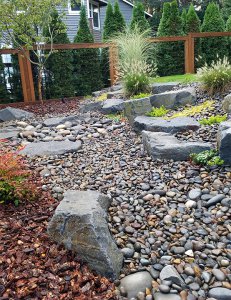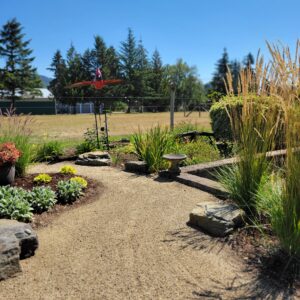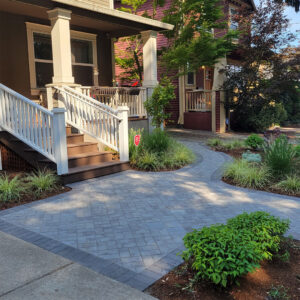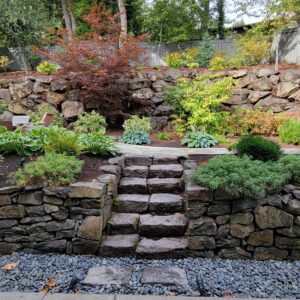A Changing Landscape: Fire-Smart Landscaping in 2024
As climate change drives more frequent and severe wildfires, homeowners must balance water conservation with fire-resistant design to protect their properties without sacrificing beauty. The resources referenced in this article are listed at the bottom of the page.
During Portland’s record-breaking heat wave in June 2021, I was interviewed by OregonLive writer Janet Eastman for an article titled “Fire-Smart Landscaping Doesn’t Have to Look Like the Desert.” Since then, the conversation around fire-resistant landscaping has only grown more urgent.
Water Conservation vs. Fire-Smart Landscaping
For decades, residential landscaping has focused on water conservation. Now, as climate conditions shift, homeowners must think beyond drought-tolerant plants and incorporate fire-resistant strategies. This dual approach presents both opportunities and challenges, influencing plant selection and design styles.
When it comes to plants, using deciduous trees and plants with low sap or resin while avoiding high resin conifers may become the new norm. There are many good sources of information on fire-resistant plants, but one of my favorites is the forty-four page “Fire-Resistant Plants for Home Landscapes,” published by the Oregon State University Extension Service.
Fire-Smart Landscaping for Urban Yards
Urban landscapes can integrate fire-resistant principles by:
- Minimizing foundation plantings to reduce fire spread near structures.
- Avoiding tall plants near homes and keeping tree branches away from roofs.
- Planting in clusters to create natural firebreaks.
- Breaking up borders with stone, pavers, or grass.
- Replacing mulch with succulent groundcovers that retain moisture.
- Maintaining a healthy, well-watered lawn to slow fire progression.
- Terrace slopes with natural or constructed stone to slow fire.
Fire-Smart Landscaping for Large Lots & Rural Homes
Fire smart landscaping for larger homes and rural homes that are higher risk requires a different way of thinking about the landscape.
- Divide your property into fire zones
- Create defensible space (see Oregon.gov’s defensible space self-certification)
- Keep firewood and lumber away from the house and wooded areas
- Ensure good access for emergency vehicles, keep space under wood decks and stairways clean and includes
- Remove dead branches and flammable material from the roof and gutters
- Avoid fuel ladders (dead or live vegetation that allows fire to climb into the tree canopy)
Work with a Professional Landscape Designer
The best way to ensure your landscape is both fire-resistant and beautiful is to consult a professional landscape designer. By assessing your property’s risk factors and implementing smart design strategies, you can create a resilient outdoor space that enhances both safety and aesthetics.
If you’re ready to take the next step in protecting your home from wildfire contact Harmony Design Northwest for expert guidance and personalized fire-smart landscaping solutions.
Here are some photos from our projects that showcase fire-resistant landscape features.
- Keep foundation planting low to the ground.
- Opt for patios instead of plants in front of your home.
- Break up the landscape with stone swales like this one.
- Incorporate wide paths of decomposed granite paths to slow down fire.
- Use a paver entry as a fire break.
- Use retaining walls on sloped properties to slow fire
Resources for Fire Resistant Landscaping:
Wildfire Safety Guide: a complete resource for strengthening your home against wildfire from Cutter Law P.C.
Fire Resistant Plants for Home Landscapes: more than 150 plants safe for fire-smart landscapes from the Oregon State University Extension office
Creating A Firewise Landscape: a helpful resource from the good folks at Cornell Farms Nursery & Cafe. Includes lists of fire-wise groundcovers, perennials, shrubs and trees
Fire Protection Tips: an infographic from the ORegon Department of Forestry
If you are dreaming about a new outdoor space in Portland, OR or Vancouver, WA, now is the perfect time to get started with an award-winning landscape design firm. Contact us today to schedule a Discovery Call.

